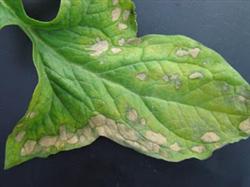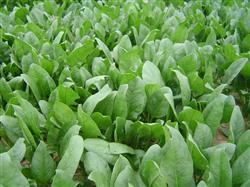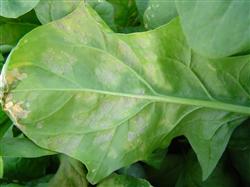Symptoms and control techniques of downy mildew in spinach

Downy mildew is a common disease of spinach, and the damage degree varies among years. Downy mildew of spinach is an obligate parasite, which only damages spinach. I. Symptoms Spinach downy mildew can infect leaves locally or systemically. When the leaves were infected locally, the affected parts were light green water-soaked circular spots at the beginning, and then expanded into irregular yellow spots, the edges were not obvious, and gray mold layers were produced on the back, and then they became purple-gray. Generally, the lower part of the plant first disease, gradually upward development, drought when the disease leaves yellow, humidity is easy to rot. When the system was infected, the diseased plant was atrophied, and a large number of purple-gray mold layers were produced on the back of the leaves. When it was serious, the diseased spots covered the whole leaves, and the leaves were withered. When the humidity was high, it caused rot. II. Route of transmission and conditions of disease The pathogen overwinters as hyphae on spinach and seeds or as ospores in diseased plants. In the following year, sporangia are produced and spread by air flow, rain, irrigation water, farm tools, insects and agricultural operations. The sporangia invade through stomata or epidermis and repeatedly infect under 7~16℃, rainy and humid conditions. The most suitable growth period of spinach downy mildew is when there are more than 5 leaves; the peak period of incidence is March to April in spring and September to December in autumn; generally, the incidence is light when there is less rain in spring, and the incidence is heavy when there is more rain in autumn. Perennial continuous cropping plot, adjacent to or continuous cropping with other frequently occurring downy mildew vegetables, low-lying, easy to accumulate water, too high sowing density, closed field, poor permeability, serious disease. III. Prevention and control methods 1, agricultural control seriously ill plots to implement 2~3 years rotation; strengthen cultivation management to achieve moderate density planting, reasonable irrigation; found infected plants removed in time; after harvest to remove residual branches and leaves. 2. Seed dressing can select 30% ruidumei or 25% metalaxyl wettable powder for seed dressing, and the dosage is 0.3~ 0.4% of seed weight. 3. Chemical control and spraying control in the early stage of disease, once every 7~10 days, continuous spraying 2~3 times. 58% metalaxyl manganese zinc wettable powder 500 times solution, 50% tuijunte wettable powder 500 times solution, 64% toxoalum wettable powder 500 times solution, etc. can be selected. If the disease occurs seriously, spray control can be carried out by spraying 800 times solution of 72% Kelu WP or 500~600 times solution of 50% Anke Mangzinc WP.
- Prev

Cultivation Techniques of Spinach in Four Seasons
1. Sowing date and variety Autumn spinach is the main crop of spinach production. Generally, it can be sown in August to September, or it can be sown in advance to July or delayed to early October. It can be harvested in batches 30~40 days after sowing. Variety selection requirements are not strict, but early autumn spinach should be selected more heat-resistant, fast-growing early varieties, such as ploughshare spinach, Chinese spinach...
- Next

Prevention and comprehensive treatment of downy mildew in spinach
The disease is caused by a fungus called spinach downy mildew. It mainly harms the front of the leaf, the disease spot is yellowish, irregular, of different sizes, 3-17 mm in diameter, and the edge is not obvious. After the disease spot enlarged, it connected with each other and became brown and withered in the later stage, and the gray-purple mildew layer was produced on the disease spot on the back of the leaf. The disease comes from the outer leaves.
Related
- Where is it suitable to grow horseradish in China? it is expected to see the middle altitude horseradish in Alishan.
- How to prevent tomato virus disease reasonably? (Control methods included)
- Many people like to plant towel gourd on the balcony. What are the main points of this method and management?
- What crops can chili peppers be mixed with?
- Fertilization techniques and matters needing attention in Tomato
- What are the grafting techniques for peach seedlings in spring?
- Harm and control methods of root swelling disease of Chinese cabbage
- What are the pests of sweet potatoes? How to prevent and cure it?
- Symptoms, causes and Control methods of navel Rot in Tomato
- The cause of "Cucumber rotten bibcock" in Farmers' planting Cucumber and its Control Plan

